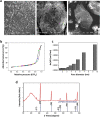Melanin is a plenteous bioactive phenolic compound in date fruits (Phoenix dactylifera L.)
- PMID: 35459886
- PMCID: PMC9033825
- DOI: 10.1038/s41598-022-10546-9
Melanin is a plenteous bioactive phenolic compound in date fruits (Phoenix dactylifera L.)
Abstract
Date palm fruits (Phoenix dactylifera L.) were found to contain high levels of allomelanin (1.2-5.1%). The melanin is localized in the tanniferous cells between the inner and outer mesocarp tissues of the fruit. The melanin, extracted with 2 M sodium hydroxide, consisted of amorphous graphene-like granular structures of irregular shape and variable size. The date fruit melanin mainly comprises carbon (64.6%) and oxygen (30.6) but no nitrogen, and was thermally stable. It has radical scavenging (63.6-75.1 IC50, µg/mL), antimicrobial (250-1000 µg/mL), hypoglycemic (51.8-58.2%), and angiotensin-converting-enzyme inhibitory (65.8%) effects. The high level of melanin in date fruits highlights the importance of investigating its dietary intake and its impact on nutrition. This study also suggests that date fruit melanin can be a functional ingredient in foods, food packages, pharmaceuticals, and cosmetics.
© 2022. The Author(s).
Conflict of interest statement
The authors declare no competing interests.
Figures







References
-
- Ghnimi S, Umer S, Karim A, Kamal-Eldin A. Date fruit (Phoenix dactylifera L.): An underutilized food seeking industrial valorization. NFS J. 2017;6:1–10. doi: 10.1016/j.nfs.2016.12.001. - DOI
-
- Xu CC, Wang B, Pu YQ, Tao JS, Zhang T. Advances in extraction and analysis of phenolic compounds from plant materials. Chin. J. Nat. Med. 2017;15:721–731. - PubMed
-
- Alam MZ, Alhebsi MSR, Ghnimi S, Kamal-Eldin A. Inability of total antioxidant activity assays to accurately assess the phenolic compounds of date palm fruit (Phoenix dactylifera L.) NFS J. 2021;22:32–40. doi: 10.1016/j.nfs.2021.01.001. - DOI
Publication types
MeSH terms
Substances
LinkOut - more resources
Full Text Sources
Other Literature Sources

